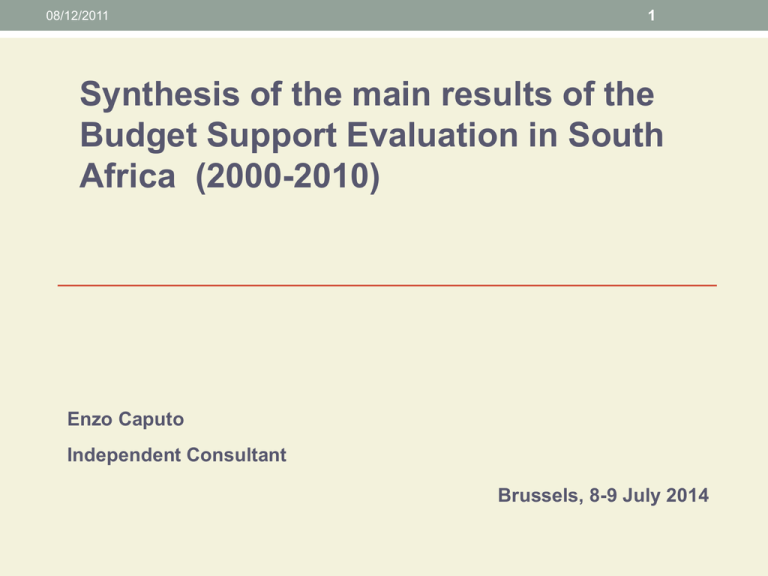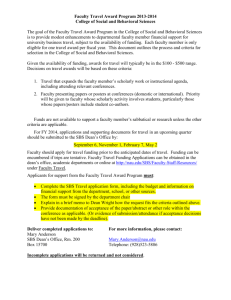6.bs_results-south_africa
advertisement

08/12/2011 1 Synthesis of the main results of the Budget Support Evaluation in South Africa (2000-2010) Enzo Caputo Independent Consultant Brussels, 8-9 July 2014 Key elements of the South African Context South Africa (SA): a middle income country. 2. ODA = 1.3% of the national budget. Specificities of the Reconstruction and Development Programme Fund. 3. Role of National Treasury in strengthening ownership and increasing alignment and harmonisation of ODA. 4. The SA-EU Trade and Development Co-operation Agreement (TDCA), and the SA-EU Strategic Partnership/Joint Action Plan: an opportunity for a wide exchange of policy experience. 1. Shift from support to rehabilitation (1994-2000), to policy support: SBS key instrument of this evolution. Scope of the analysis - Overview of the SBS interventions Pre-TDCA TDCA EU-SA strategic partnership RCF I Gov. Wat. Soc. Urb. Post-Apartheid Reconstruction Eco. RCF II SWEEP I&II Employment creation Innovation for poverty alleviation Legislative SSP Access to Justice & HR e-Justice Masibambane I Masibambane II NDPS P Masibambane III Partnership for Health II PrimHealth PrimEdu Urban development support to e-Thikwini Urban renewal programme in the Eastern Cape Other non-budget support interventions: e.g. LED programmes, TABEISA, HIV & higher education, Victim empowerment programme, TDCA Dialogue Facility…TOTAL BS = 1bn € over 10 years 2000 2001 2002 2003 2004 2005 2006 2007 2008 2009 2010 2011 2012 South Africa: Main findings on Step 1 Ratio of RDP receipts to total ODA flows to South Africa • Despite the reduced amounts, SBS funds have strengthened the ownership of GoSA over development cooperation funds. 100% 90% 80% 70% 60% 50% 40% 30% 20% 10% 0% 2000 2001 2002 2003 2004 2005 2006 2007 2008 2009 2010 2011 EU All donors except US All donors Sources: National Treasury/RDP audited reports, National Treasury/IDC data for RDP receipts reported on the basis of fiscal years and http://stats.oecd.org/qwids/ for ODA data reported on the basis of calendar years. • Very high rates of disbursements & high predictability of SBS disbursements: on average 95% of forecasted funds were disbursed within the same fiscal year; these averages however hide major delays in the payment of a number of tranches. Share of SBS funds as % of additional allocations … thereby increasing the fiscal space for key policy experimentation. • 140% 120% 100% 80% 60% 40% 20% 0% Sources: own calculations based on data retrieved from the Budget Reviews (2001-2011) for GoSA additional allocations and EUD data for SBS commitments. Effects on Public Spending / Budget management 1. Strengthened Treasury’s capacity to provide rapid and flexible responses to the requests of funds for innovative policies and pilot initiatives, in targeted sectors. 2. No important contributions to national or local PFM improvements. Good PFM has been a success factor rather than an SBS contribution. The SA-EU dialogue framework Strategic Partnership Joint Action Plan (JAP) (2007) SADC-EU Berlin initiative Parliamentary dialogue TDCA (signed in 1999, fully implemented in 2004) Agreement on S&T co-operation (1997) Africa-EU strategic partnership Cotonou Partnership agreement Political dialogue (JAP + Title I) Joint Co-operation Council Summits Annual SADC EPA Trade: Titles II & III Trade cooperation council Tax & Customs Economic cooperation: Titles IV Other areas: Titles VI Energy ICT Civil aviation Maritime transport Migration Environment S&T Health Social Education/ dialogue Training Justice & crime Dialogue forums Statistics Development co-operation: Titles V Annual consultations Specific interventions MDP 6 monthly Senior Official PSC & ad hoc Policy Dialogue & Capacity development 1. 2. 3. Two dimensions of dialogue: • Policy dialogue directly linked to BS (exchange on the specific programmes, performance assessment framework, assessment of KPI…) => strong since the beginning of the evaluation period (Water, Urban Development, SWEEEP…). • Policy dialogue that takes place at the broader level of the strategic partnership (sharing of lessons learnt) => increased and successful attention in the second part of the period (Health, Governance…, but not Employment and Education). SBS has supported capacity development through strong effective mobilisation of national technical resources (Water, Employment…), and through innovative CSO involvement (Justice, Health…). Link between capacity development and exchange of know-how has shown important contributions in the second period (Health…). Summary on the direct contributions of the SBS package 1. The various components of the SBS package have operated in different ways in each programme: 2. The role of funds was usually significant, while the strength and the quality of dialogue depended on a number of factors. Some examples on the contribution to policy experimentation: Innovation for Poverty Alleviation (Funds and SP). Risk Capital Fund (Funds and Knowhow). PrimCare (Funds and Knowhow). Access to Justice (Funds and dialogue-trust). South Africa: Main findings on Step 2 and Step 3 Water and Sanitation Sector - Key findings • Main changes at outcome/impact level: Significant achievements in terms of increased access to water and sanitation facilities and, to a lesser extent, in terms of the quality of the drinking water. Maintenance and operations remain weak. Households with access to piped water (provincial and national level) 100% 90% Western Cape 80% Eastern Cape Northern Cape 70% Free State KwaZulu-Natal North West 60% Gauteng Mpumalanga 50% Limpopo South Africa 40% 30% 2002 2003 2004 2005 2006 2007 2008 2009 2010 Sources: own calculations based on data from the GHS survey (2002-2011). 2011 Water and Sanitation Sector - Key findings • Determining (policy and historical) factors: New sector strategies and huge public investment (high political priority). Transfer of WATSAN responsibilities to local government and support at local level (Masibambane) have proven determinant for success in the poorest areas. New approach to sector collaboration. Persistent weaknesses in capacities at municipal level. Low involvement of CSOs. • Contribution of SBS (especially in the first period) via: Support to the establishment of a new comprehensive strategy through Masibambane. Build capacities at local government level & promotion of sector leadership. Promotion of a wide range of innovative pilot projects. Weak dialogue in the second phase to stress the CSO component (SBS strategic dialogue has lost some of intensity in the second period).







